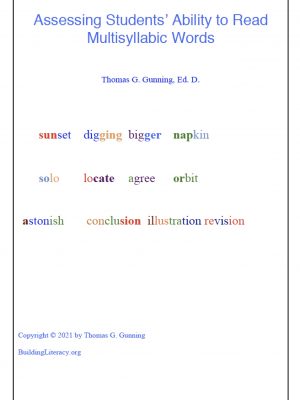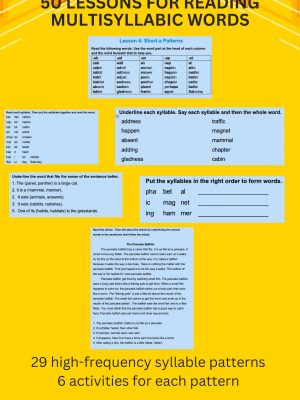Foundational Literacy Booster: 50 Lessons for Reading Multisyllabic Words presents major multisyllabic patterns.
Foundational Literacy Booster: 50 Lessons for Reading Multisyllabic Words
Foundational Literacy Booster: 50 Lessons for Reading Multisyllabic Words, is designed to develop in all readers, but especially those who struggle, the ability to read multisyllabic words. Carefully sequenced, the program builds on students’ knowledge of single-syllable patterns and their increasing knowledge of multisyllabic patterns. Students build on their knowledge of short-vowel patterns, such as -ab, -it, –ag, and – et, to learn multisyllabic patterns composed of short-vowel patterns (rabbit, magnet). After learning short-vowel multisyllabic patterns, students are introduced to patterns that combine both short-vowel and long-vowel patterns (raven, invade). Later, r-vowel patterns (starfish, turkey) and other-vowel patterns (cartoon, thousand) are combined with previously presented short- and long-vowel patterns. Three-, four-, and five-syllable words are gradually introduced along with advanced patterns that appear only in multisyllabic words (adventure, connection). Group and individual placement tests are provided.
Varied practice and application activities include reading words, sentences, and passages that gradually increase in difficulty and so boost students’ reading ability. Foundational Literacy Booster: Reading Multisyllabic Words is designed to boost students’ reading level from a beginning second to a third-grade or fourth-grade reading level. Sentence exercises and articles consist of informational text and so build background and provide practice with nonfiction text while at the same time developing the ability to read multisyllabic words.
Emphasis has been placed on making key concepts understandable and memorable. For instance, the word robot is highlighted as a word that contains an open and closed syllable with a resulting long o and short o. Students also complete exercises in which dinner at the diner; super suppers; tiny, tinny robots; and winners and whiners are discussed.
To apply skills, students read about such high-interest topics as the use of giant stones for money, giant spiders, pirate treasure, the planet Mercury, traveling to Mars, and the world’s smartest dogs. Riddles, rhymes, jokes, and songs that reinforce target patterns are also featured.
Combining the best features of structured literacy, which emphasizes direct, systematic, intensive instruction with a balanced holistic approach, which stresses extensive reading and writing, Building Foundational Literacy is a classroom- and clinic-tested, research-based program designed to build a foundation of preparatory and basic literacy skills. The program is designed so that it provides an effective approach for achieving readers as well as disabled readers, including those identified as having dyslexia. Building Foundational Literacy is composed of five levels:
- Beginnings: Beginning and final consonants, short a, and high-frequency words. Available 9-1-20.
- Level A: Short-vowel patterns, blends, and high-frequency words
- Level B: Long-vowel patterns, blends, and high-frequency words
- Level C: R-vowel patterns, other-vowel patterns, blends and high-frequency words
Building Foundational Literacy Resources features extensive teaching suggestions and exercises for Levels A, B, and C. Building Foundational Literacy: Reading Selections A, B, and C is a three-book series of high-interest decodable selections that reinforce the patterns and skills presented.
- Level D: Multisyllabic patterns. Foundational Literacy Booster: 50 Lessons for Reading Multisyllabic Words presents major multisyllabic patterns.
For a preview, click on the following links:
Building Foundational Literacy Resources
Building Foundational Literacy Resource Sample Lessons
Building Foundational Literacy: Decodable Reading Selections Level A Table of Contents
Building Foundational Literacy: Decodable Reading Selections Level A Sample Lessons
Building Foundational Literacy: Decodable Reading Selections Level B Table of Contents
Building Foundational Literacy: Decodable Reading Selections Level B Sample Lessons
Building Foundational Literacy: Decodable Reading Selections Level C Table of Contents
Building Foundational Literacy: Decodable Reading Selections Level C Sample Lessons
Clozing the Literacy Gap: Booster Passages, which is designed to boost the reading levels of below-level readers, consists of increasingly difficult sets of modified cloze informational passages and is currently being revised. In modified cloze activities, students choose from three options the one that best completes a (satisfied, sentence, seven). Modified cloze builds basic sentence comprehension. It is an especially corrective activity for students who over-rely on sounding out and fail to read for meaning. It is also an effective corrective for students who take a quick glance at a challenging word and guess what the word might be, for instance misreading comprehend as company.
Exercises are set up in such a way, that students need to examine the whole word in order to respond correctly. Many of the foils or incorrect answers are constructed in such a way that students must choose from items that are similar to the correct response as in this sentence:
An ostrich can flap its (wigs, winds, wings).
Other foils require an understanding of the sentence and, in some cases, portions of or the entire selection as in: The ostrich has a sharp claw on each (feather, finger, foot.) Passages contain helpful contextual clues and phonetic (fuh-NET-ik) respellings of hard-to-pronounce words. Through the use of contextual clues and phonetic respellings, students’ vocabulary is built while at the same time they gain experience with using these two exceptionally valuable decoding strategies. Exercises are also designed to be appealing and motivational. Selections are brief and features intriguing subjects and topics. So as to build a depth of background and understanding, many of the subjects are explored in multiple passages.
Exercises are also reader friendly. Instead of having to write lengthy responses, students are merely selecting the correct response. Student answer guides and progress charts are provided so that students can check their responses and track their progress by noting number of correct responses, number of selections read, and number of words read, and upward movement into higher levels. Because choice is a highly motivating factor, students may occasionally skip passages that don’t look interesting to them. As a practical matter, skips need to be limited. Students may skip one passage out of every ten.
Realizing that time and resources are limited, the purpose of Booster Passages is to make effective use of students’ time and effort so as to supplement programs provided by the school. Based on the theory of deliberate practice, students can boost reading proficiency by reading and responding to passages on the appropriate level that gradually increase in difficulty as the students move into higher levels of proficiency.
Feedback is provided to the students when the students check their responses and track progress. Thus, time put in by the students is in addition to that provided by the school and should accelerate progress. This is especially important when students are significantly below grade level and need to advance several levels.
Rhymes include traditional nursery rhymes, jumping rope rhymes, limericks, and poems by Robert Louis Stevenson and Christina Rossetti. Songs feature such traditional works as “If You’re Happy and You Know It,” “Oh Suzanna,” “Twinkle, Twinkle, Little Star,” and “Take Me Out to the Ball Game.”
The rhymes and songs are arranged in alphabetical order. However, at the
foot of each rhyme and song is a notation indicating the skill(s) that it might be
used to reinforce. Skills are listed in the index according to the sequence
in which they are typically taught: short vowels, long vowels, r vowels, and other
vowels (book, boot, cow, paw, boy).
Some rhymes such as “Ice Cream;” “Bow, Wow, Wow;” “Fears and Tears;” “Fright and Bright;” and “I Saw Esau ”emphasize a particular pattern. Others, such as “Row, Row, Row Your Boat” and “The Donkey” emphasize two patterns. Of course, many of the rhymes and songs can be used to reinforce a variety of patterns and skills

